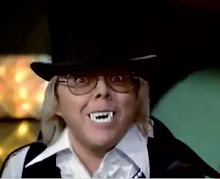
Seventy years before Stephanie Meyers sent many of the double X chromosone possessing population into inexplicaple hysterics with her own brand of Byronic Blandness there was another (literally) toothless vampire tale that made audiences quiver.
How could a movie as slight as Tod Browning’s Dracula become one of American cinema’s most culturally important films? Even for 1931 standards (as its Irish twin Frankenstein illustrates) most of the film is extremely dull stuff. The real shocker of the film is how quickly the dreamlike monster fable becomes a nearly unwatchable parlor based melodrama. The atmospheric sets are replaced with some of the most humdrum interiors ever committed to film. In this setting Lugosi’s undead predator is transformed into a middle-aged weirdo whose second language is English and has a wooden stake up his coattailed posterior.
From this...

to this...not as creepy as spider castle of doom although that fireplace is pretty weird

 Is it just me or does Dracula look like he is struggling to read his contract? "I shood hav paid more attenshun in schooel"
Is it just me or does Dracula look like he is struggling to read his contract? "I shood hav paid more attenshun in schooel" Did Dracula make dinner for Renfield or did he make the brides do it? Was he in the kitchen trying to remember what humans eat?
Did Dracula make dinner for Renfield or did he make the brides do it? Was he in the kitchen trying to remember what humans eat?I know what would make this movie less boring....

..a PHILIP GLASS soundtrack!
 Honesty time: Lugosi’s Dracula is one of my least favorite Lugosis. It’s not the demented hammery or spectacular oddness I like in my Lugosi roles. It’s a scientific fact that the following Lugosi performances outshine his most famous role:
Honesty time: Lugosi’s Dracula is one of my least favorite Lugosis. It’s not the demented hammery or spectacular oddness I like in my Lugosi roles. It’s a scientific fact that the following Lugosi performances outshine his most famous role:• Son of Frankenstein
• The Murders of Rue Morgue
• White Zombie
• The Raven
• The Black Cat
Actually, just about all of his Universal performances (and some of his cheapos) are better than Dracula but the performance is so mythic that it's undeniably powerful.

"This one is MINE!" (That's a True Blood reference btw)
Universal Appeal: Strong and Weak. The iconic eeriness of the first 20 minutes is a large part of our collective mythology. The beautiful matte painting mountains, the “children of the night” line, the brides, and Dwight Frye’s freak out on the boat are all immortal classics. The rest of the movie (with the exception of the cigarette case mirror smash) is immediately forgettable. As someone who was born six years after Star Wars it is impossible for me to understand how audiences felt seeing and hearing the first talking supernatural horror picture. I would assume that the novelty of the original mix of sex and death (and phony fireplaces) kept Depression Era audiences captivated despite some seriously lazy filmmaking.


No no no! I won't have it, d'you here? I saw this film when I was ten and I've watched it, at a conservative estimate, ten billion times since and it's still my favourite horror movie. Can I bore you with a link? Oh good. Here goes then:
ReplyDeletehttp://carfaxabbey.blogspot.com/2009/04/1931-how-dracula-invented-modern-horror.html
Thanks for the link! That's a very unique look at the film. I've never read about the film's "Americaness" before. It is very hard for modern audiences to appreciate the novelty of the juxtaposition with this kind of material with contemporary times.
ReplyDeleteI cannot help but like Dracula (it started it all) but my gut reaction to it has never been as strong as Frankenstein or even Murders in the Rue Morgue.
I think the passing-through-the-spider-web moment is the high point of this version of Dracula.
ReplyDelete